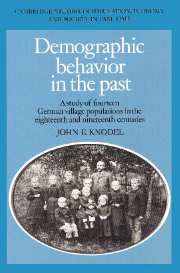 Demographic Behavior in the Past
Demographic Behavior in the Past Book contents
- Frontmatter
- Contents
- List of tables
- List of figures
- Acknowledgements
- PART I INTRODUCTION
- PART II MORTALITY
- PART III FAMILY FORMATION
- PART IV MARITAL REPRODUCTION
- PART V INTERRELATIONSHIPS IN DEMOGRAPHIC BEHAVIOR
- PART VI CONCLUSION
- 15 Population dynamics of the past: summing up
- Appendices
- Bibliography
- Index
15 - Population dynamics of the past: summing up
Published online by Cambridge University Press: 04 August 2010
- Frontmatter
- Contents
- List of tables
- List of figures
- Acknowledgements
- PART I INTRODUCTION
- PART II MORTALITY
- PART III FAMILY FORMATION
- PART IV MARITAL REPRODUCTION
- PART V INTERRELATIONSHIPS IN DEMOGRAPHIC BEHAVIOR
- PART VI CONCLUSION
- 15 Population dynamics of the past: summing up
- Appendices
- Bibliography
- Index
Summary
The preceding chapters have surveyed demographic behavior in 14 German village populations during the eighteenth and nineteenth centuries, based on reconstituted family histories included in village genealogies. They illustrate the distinctive value of micro-level data derived through family reconstitution for the study of population processes in the past, and in particular for the study of demographic transition. Most of the findings would have been impossible to obtain from conventional sources of demographic data, such as published census tabulations and vital statistics. Not only do such data not exist for much of the period covered, but since such data are already aggregated in the source, they do not permit analyses which interrelate different aspects of demographic behavior at the individual or family level. In addition, much important information known about individuals covered in a family reconstitution study derives from the reconstitution process itself. Thus information often not available from standard demographic sources, such as a child's birth order, the interval between births, or a mother's age at a particular confinement, can be determined through family reconstitution because the vital events of a family have been linked together.
Aggregate analysis of parish records is also much more limited in the extent of information provided and the extent to which such data permits the exploration of interrelationships. While there have been major methodological advances in this approach, as illustrated by the recent study of the population history of England by Wrigley and Schofield, aggregative analysis still provides only the most basic demographic measures for a population.
- Type
- Chapter
- Information
- Demographic Behavior in the PastA Study of Fourteen German Village Populations in the Eighteenth and Nineteenth Centuries, pp. 445 - 460Publisher: Cambridge University PressPrint publication year: 1988


